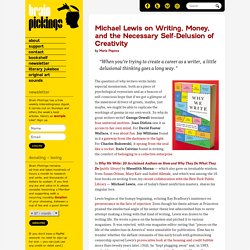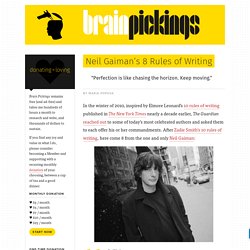

Building the World of Your Screenplay: Your First 10 Pages. Click to tweet this article to your friends and followers!

As religious lore has it, God took 6 days to build the world… You have 10 pages. You’ve all heard the horror stories of producers who only read the first 10 or 20 pages, and if they’re not hooked, intrigued and impressed, they toss the script. And unfortunately, those stories are true. So you need to make sure your first pages accomplish all the things necessary to keep a reader’s interests. You need to paint a picture in your first few pages that make it clear your story is visual and your writing is interesting. 8 Tips For Creating Great Stories From George R.R. Martin, Junot Diaz, And Other Top Storytellers.
What the hell is a Story Lizard?

In Wonderbook: The Guide to Creating Imaginative Fiction (Abrams Books, October 15), Story Lizards join Prologue Fish and other infographic helpmates designed to banish dry textual analysis in favor of a kicking, screaming, slithering approach to storytelling creativity. Author Jeff Vandermeer, a three-time Fantasy World Award-winning novelist who co-directs the Shared Worlds teen writing camp, says "The way we're taught to analyze fiction is to break down and do a kind of autopsy. But I think writers need to be more like naturalists or zoologists when they study story because then you're looking at how all the elements fit together. " Enter the Story Lizard, above, illustrated by Jeremy Zerfoss. How Creativity Works: Neil Gaiman on Where Ideas Comes From. Download the App. MUJERES QUE ESCRIBEN; TODA UNA AVENTURA EXISTENCIAL. » There’s No Such Thing as a Fake Reader. Three people walk into a bar: the first is carrying a book of experimental poetry, the second holds a YA vampire novel, and the last sits down and opens up a Victorian classic.

Who is the “real reader”? Writers, understandably, are always seeking advice for how to better connect to readers. And there is an abundance of advice that makes claims about what readers want: “Readers want realistic characters!” “Readers crave plot!” “Readers want emotion!” Aerogramme Writers' StudioStephen King's "Everything You Need to Know About Writing Successfully – in Ten Minutes"
I.

The First Introduction THAT’S RIGHT. I know it sounds like an ad for some sleazy writers’ school, but I really am going to tell you everything you need to pursue a successful and financially rewarding career writing fiction, and I really am going to do it in ten minutes, which is exactly how long it took me to learn. It will actually take you twenty minutes or so to read this essay, however, because I have to tell you a story, and then I have to write a second introduction. But these, I argue, should not count in the ten minutes. II. The Basics – Better Storytelling. The BasicsIndex of Articles The Basics of Storytelling by William F.

Nolan As a storyteller, you must begin by creating a protagonist who is real, three dimensional, with genuine emotions that play out over the course of your narrative. Your range is … Neil Gaiman’s Advice to Aspiring Writers. Reel Story: Most Common Reasons Why Scripts Are Rejected. Whenever a script is submitted to the industry, it is passed off to a reader for analysis.

The reader will give the script a “recommend,” a “consider” or a “pass.” And unless it gets a recommend, probably no one else is going to look at it. So how many scripts get a recommend? About two percent. Which means roughly ninety-eight percent of spec scripts are dead on arrival. The Neuroscience Of "Harry Potter" Let's do a casual experiment.

Here's a brief passage from the first book in some obscure fiction series called Harry Potter: The Taming of the Shrew: Writing Female Characters & Archetypes. One of the biggest topics discussed in entertainment this year, especially the last few months, is the decrease in the number of women in the industry and especially the lack of female directors and female protagonists in cinema.

Despite there being a number of films with female leads that have become massive hits, there are still far fewer produced than those with male leads. Studios are still passing on female protagonist projects and it’s our job to figure out why instead of just bemoaning that it happens. Ursula Le Guin. Writersroom - Writersroom interviews...Steven Moffat. The Science of the Movie Screenplay. Michael Lewis on Writing, Money, and the Necessary Self-Delusion of Creativity. By Maria Popova.

Neil Gaiman’s 8 Rules of Writing. By Maria Popova In the winter of 2010, inspired by Elmore Leonard’s 10 rules of writing published in The New York Times nearly a decade earlier, The Guardian reached out to some of today’s most celebrated authors and asked them to each offer his or her commandments.

After Zadie Smith’s 10 rules of writing, here come 8 from the one and only Neil Gaiman: WritePut one word after another. Find the right word, put it down.Finish what you’re writing. How Neil Gaiman Stays Creative In An Age Of Constant Distraction. The great German writer and realpolitik statesman Goethe once said “talent is nurtured in solitude.” The only way to achieve true creativity, then, was to become “a child of solitude.” But in our culture of constant connectivity, is solitude still needed, let alone possible? And when creators come down to Earth via Twitter, Facebook, and email, making themselves more publicly accessible than ever before, is there any hope for pure, untempered creation?
How Stephen King Teaches Writing. David Foster Wallace on Writing, Self-Improvement, and How We Become Who We Are. By Maria Popova “Good writing isn’t a science. How to Write For Any Medium (From a Guy Who's Written For "The New Yorker," "Saturday Night Live," and Pixar) Aside from the fact that his name is right there at the top of the page, it’s always fairly obvious when a "Shouts and Murmurs" piece in The New Yorker is the product of Simon Rich. Bob Dylan on Sacrifice, the Unconscious Mind, and How to Cultivate the Perfect Environment for Creative Work. By Maria Popova “People have a hard time accepting anything that overwhelms them.” Van Morrison once characterized Bob Dylan (b.
Kafka on Books and What Reading Does for the Human Soul. Elmore Leonard’s 10 Rules of Writing. 10 Tips on Writing from David Ogilvy. Jack Kerouac’s List of 30 Beliefs and Techniques for Prose and Life. H. P. Lovecraft’s Advice to Aspiring Writers, 1920. How to Be a Writer: Hemingway’s Advice to Aspiring Authors. Pixar's 22 Rules of Storytelling. Note: This article is included in our year-end storytelling advice round-up. The Most Moving and Timelessly Beautiful LGBTQ Love Letters in History. Correspondence Course: John Moe Is Deconstructing Pop Culture, One Letter At A Time. From A Guy Who Went From "Daily Show" Intern to Head Writer. "The Fault In Our Stars" Author John Green On Building A Passionate Audience. ¡¡Quiero publicar una novela!! ¿Qué hago? ¡Hola a todos! Hoy voy a dedicar la entrada del blog a responder de manera genérica a todos los que me preguntáis por e-mail, Facebook, Tuenti, comments de blog, etc etc... cómo publicar una novela.